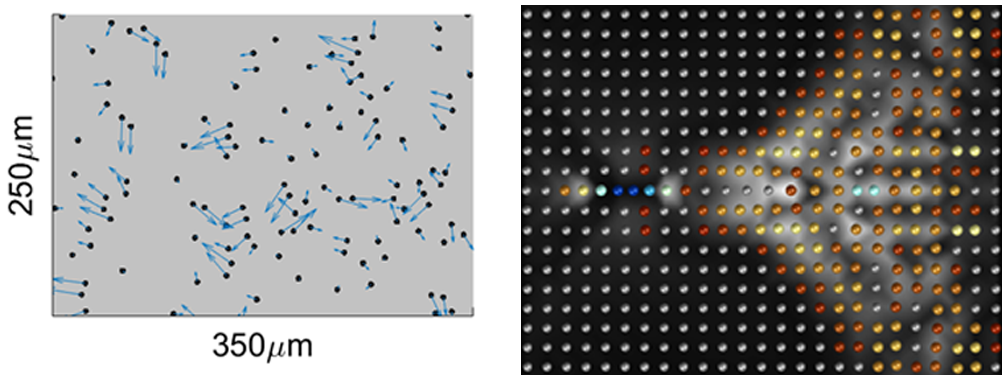The world of physics has been split between classical and quantum physics with the advent of quantum mechanics. Classical physics deals with the motions of objects one gets to normally see daily in the macroscopic world, while the exotic behaviors of elementary particles in the microscopic world have been described by quantum physics.
 Left: Experimental measurement of colloidal particles driven in a thin microfluidic channel. The particles form stable, hydrodynamically coupled pairs moving at the same velocity (arrows). These pairs are the fundamental quasiparticles of the system. Right: Simulation of a hydrodynamic crystal, showing a quasiparticle pair (leftmost yellow and orange particles) propagating in a hydrodynamic crystal, leaving behind a supersonic Mach cone of excited quasiparticles. Colors denote the magnitude of the pair excitation, and the white background denotes their velocity (see movie). Image Credit: Institute for Basic Science.
Left: Experimental measurement of colloidal particles driven in a thin microfluidic channel. The particles form stable, hydrodynamically coupled pairs moving at the same velocity (arrows). These pairs are the fundamental quasiparticles of the system. Right: Simulation of a hydrodynamic crystal, showing a quasiparticle pair (leftmost yellow and orange particles) propagating in a hydrodynamic crystal, leaving behind a supersonic Mach cone of excited quasiparticles. Colors denote the magnitude of the pair excitation, and the white background denotes their velocity (see movie). Image Credit: Institute for Basic Science.
Several solids or liquids are made of particles communicating with one another at close distances, which sometimes leads to the increase of “quasiparticles.” Quasiparticles are long-lived excitations that tend to act in an efficient manner as weakly interacting particles.
The concept of quasiparticles was introduced by the Soviet physicist Lev Landau in 1941. Since then, it has been highly productive in quantum matter research. A few instances of quasiparticles include Bogoliubov quasiparticles (that is, “broken Cooper pairs”) in excitons in semiconductors, superconductivity, and phonons.
Analyzing the emergent collective phenomena regarding quasiparticles offered awareness of an extensive range of physical settings. This was done most considerably in superfluidity and superconductivity, recently in the well-known example of Dirac quasiparticles in graphene.
However, to date, the observation and usage of quasiparticles have been restricted to quantum physics. In classical condensed matter, the collision rate is normally much too high to enable long-lived particle-like excitations.
Still, the standard view that quasiparticles are limited to quantum matter has been newly challenged by a research group at the Center for Soft and Living Matter (CSLM) within the Institute for Basic Science (IBS), South Korea.
A classical system made up of microparticles was analyzed by the research group driven by viscous flow in a thin microfluidic channel. Since the particles are pulled by the flow, they tend to disturb the streamlines around them, thereby applying hydrodynamic forces on each other.
Notably, the scientists discovered that such long-range forces make the particles set up in pairs. This is because the hydrodynamic interaction breaks Newton’s third law, stating that the forces between two particles should be opposite in direction and equal in magnitude. Rather, the forces are “anti-Newtonian” since they are equal and in the same direction, stabilizing the pair.
The huge population of particles linked in pairs implied that these are the long-lived elementary excitations present in the system, known as quasiparticles. This hypothesis was proven well when the scientists simulated a large two-dimensional crystal made of thousands of particles and analyzed its motion. The hydrodynamic forces present among the particles make the crystal vibrate, similar to the thermal phonons in a vibrating solid body.
Such pair quasiparticles tend to propagate via the crystal, stimulating the formation of other pairs via a chain reaction. The quasiparticles travel quickly compared to the speed of phonons. Hence, every pair breaks away from an avalanche of newly-formed pairs, similar to the Mach cone produced behind a supersonic jet plane. At last, all those pairs tend to collide with each other, eventually resulting in the melting of the crystal.
In all crystal symmetries except for one specific case, the melting induced by pairs has been noted: the hexagonal crystal. In this context, the three-fold symmetry of hydrodynamic interaction equals the crystalline symmetry and consecutively, the elementary excitations are very slow low-frequency phonons (and not pairs as usual).
In a spectrum, one tends to note a so-called “flat band” where such ultra-slow phonons condense. The interaction among the flat-band phonons seems to be highly collective and associated, which displays the much sharper and different class of melting transition.
Remarkably, when analyzing the spectrum of the phonons, the scientists determined conical structures typical of Dirac quasiparticles, similar to the structure discovered in the graphene’s electronic spectrum.
As far as the hydrodynamic crystal is concerned, the Dirac quasiparticles are just particle pairs, which form as a result of the “anti-Newtonian” interaction mediated by the flow. This illustrates that it is possible for the system to act as a classical analog of the particles found in graphene.
The work is a first-of-its-kind demonstration that fundamental quantum matter concepts—particularly quasiparticles and flat bands—can help us understand the many-body physics of classical dissipative systems.
Tsvi Tlusty, Study Corresponding Author, Institute for Basic Science
Furthermore, quasiparticles and flat bands are of exceptional interest in condensed matter physics. For instance, flat bands were noted recently in double layers of graphene that have been twisted by a particular “magic angle,” and the hydrodynamic system studied at the IBS CSLM happens to display an analogous flat band in an easier 2D crystal.
Altogether, these findings suggest that other emergent collective phenomena that have been so far measured only in quantum systems may be revealed in a variety of classical dissipative settings, such as active and living matter.
Hyuk Kyu Pak, Study Corresponding Author, Institute for Basic Science
Journal Reference:
Saeed, I., et al. (2022) Quasiparticles, flat bands and the melting of hydrodynamic matter. Nature Physics. doi.org/10.1038/s41567-022-01893-5.